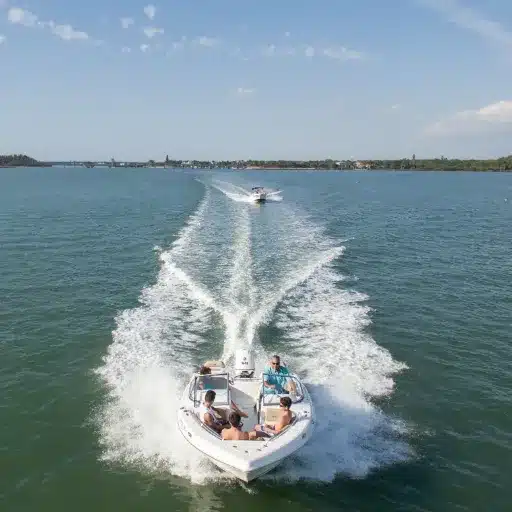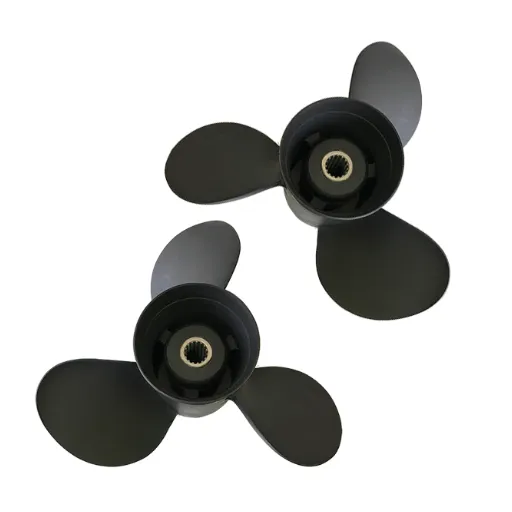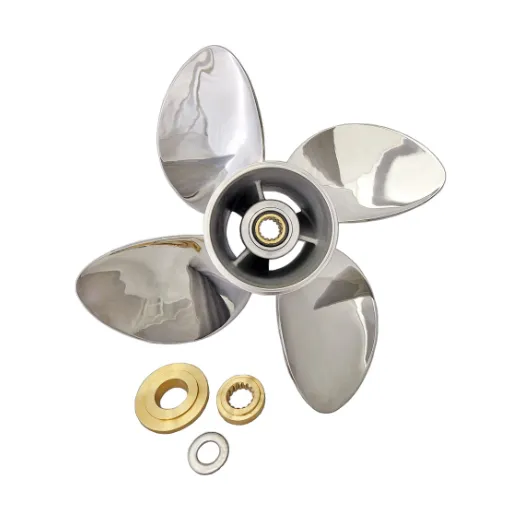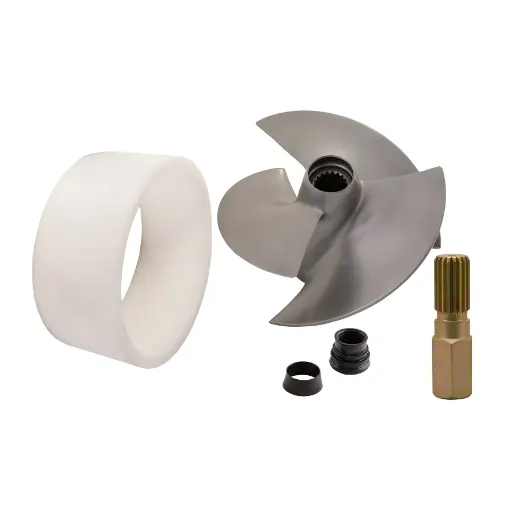Safe speed is generally considered one of the most critical factors in ensuring the safety of a vessel at sea. Until recent times, safe navigation would be influenced by factors as simple as weather or visibility. Advances in technology, evolving regulations, and increasing traffic imply that very complex factors need to be accounted for in the act of safe navigation. The guide will serve as a vital reference for operators, maritime safety professionals, or even laymen in specifying the process for evaluating and determining safe operating speeds of vessels. You will learn to look at certain factors that should influence the setting of safe speeds for vessels, such as environmental conditions, the type and performance characteristics of the boat, traffic concentration, and relevant maritime legislation. Equipped with the knowledge of these influencing criteria, you will be able to set safe speeds while considering safety, operational efficiency, and regulations on a case-by-case basis.
Understanding Safe Speed for Your Vessel
Definition of Safe Speed
Safe speed is the speed at which a vessel may be operated to be effectively under control to avoid collisions or accidents under the circumstances existing. Determination of safe speed involves considering a series of factors, such as visibility, traffic density, clearance from navigational hazards, and the vessel’s maneuverability regarding stopping distance and turning ability in the prevailing conditions.
⚓ When Safe Speed Should Be Adjusted:
- During fog, heavy rain, or nighttime operations: Vessel speed should be adjusted to allow ample time to react to unexpected obstructions
- In congested waterways: Such as ports or shipping lanes, speed reduction is required to prevent collisions
- Poor visibility conditions: Consider technological factors such as radar performance and reliability
Safe speed shall be used in various instances depending on visibility, amount of traffic, maneuverability of the vessel, weather conditions, and other factors affecting safe navigation: during fog, heavy rain, or nighttime operations, a vessel’s speed should be adjusted regarding the need to have ample time in reacting to an unexpected obstruction. In congested waterways, such as ports or shipping lanes, speed reduction shall be further required to prevent collisions caused by the movement of other vessels. In fact, considering technological factors such as radar performance and reliability is an essential aspect of operational safety, especially in areas where navigation from visual sources is poor.
The regulatory framework sets other safety requirements, primarily outlined in the International Regulations for Preventing Collisions at Sea (COLREGs), which emphasize the need for safe speed and the responsibilities of masters or those in charge to exercise sound judgment in this matter. Applying these principles will be an excellent means for risk minimization and, as a result, support efforts in maritime safety, where navigation is performed in various environments of the contested naval domain.
Safe Speed: The Need for Its Determination
Speed determination must consider multiple criteria. Yet the recommended safe speed must consider external, operational, and technical factors. Key considerations are visibility, traffic, vessel maneuverability, hazards, and sea state. For example, one factor that compels a ship to go slower than usual is if fog or heavy rain sets in, allowing enough time to react to an event. Engineering calculations for safe speed also consider the need to slow down in areas with heavy traffic, such as busy shipping lanes and ports, to avoid collisions.
| Factor Category | Key Considerations | Impact on Speed |
|---|---|---|
| External Factors | Visibility, weather conditions, sea state | Reduced visibility requires slower speeds |
| Operational Factors | Traffic density, navigational hazards | Heavy traffic demands speed reduction |
| Technical Factors | Vessel maneuverability, stopping distance | Larger vessels need more time for corrections |
From a technical perspective, a safe speed should be considered in terms of a vessel’s ability to stop within a particular distance or turn. Larger ships have more inertia, so that the reduced speed can be maintained for a sufficient time to take necessary corrective actions. This becomes even more important in cases that prompt emergency action, requiring rapid alterations of course or rapid stoppage. Finally, modern navigational aids and RADAR can detect dangers much earlier, and these need to be considered so that vessels remain aware of their surroundings even in adverse conditions.
📊 Safety Data: The data taken from maritime safety studies highlights how increasing speed increases the chances of accidents. It points out that prudence must be exercised in speed levels to minimize risks. And for better safety and efficiency on the water, operators are to employ real-time assessments of these factors using the latest maritime technology and giving regard to the relevant statutory guidelines.
Regulatory Framework: Rule 6 and Its Implications
Rule 6 of the International Regulations for Preventing Collisions at Sea (COLREGs) states that a vessel shall always proceed at a safe speed to allow for proper and effective action to avoid collisions and stop within a reasonable distance. The determination of a secure speed will thus depend on certain factors such as visibility, traffic density, maneuverability of the vessel, weather conditions, and its proximity to navigational hazards.
📜 Rule 6 Key Requirements:
- Always proceed at a safe speed to allow proper action to avoid collisions
- Maintain ability to stop within a reasonable distance
- Consider visibility conditions and adjust accordingly
- Account for traffic density in decision-making
- Assess vessel maneuverability and weather conditions
- Maintain awareness of proximity to navigational hazards
With decreased visibility due to heavy fog or precipitation, operators must reduce vessel speed while maintaining reaction capability. Increased vessel density in congested waterways calls for speed adjustments that consider sudden, unexpected maneuvers from the vicinity. Technological improvements like radar, AIS, and electronic charting enable a vessel to determine a safe speed of operation in periodic assessments of environmental and traffic data.
A careful examination of global accident investigations and safety auditing reveals that maritime accidents can frequently be attributed to a violation of Rule 6. Regulatory bodies have thus shown how vessel speed links directly with the potential for collision, further highlighting the importance of defect-free compliance with Rule 6. Having said that, integration of state-of-the-art prediction algorithms into navigation systems will help operators finalize their decisions while still maintaining safekeeping and operational efficiency.
💡 Key Insight: Rule 6 is not merely one of the statutory requirements; rather, it should be seen as another method to mitigate risk at sea. Its pertinence allows one to grasp the importance of coupling regulations with advanced maritime technology and continuously monitoring the surroundings to uphold the highest maritime safety standards.
Key Factors in Determining Safe Speed
Traffic Density and Its Impact on Speed
The concentration of traffic is more or less directly proportional to the speed considered safe. On the other hand, a bulky traffic alert or caution a mariner to reduce speed to avoid any collision. Generally, the risk of a crash is high in areas of heavy traffic, such as port entrances, busy shipping lanes, or navigation bottlenecks, because vessels have reduced time to maneuver. Modern AIS facilitates the provision of real-time traffic information to assist a boat in adjusting its speed and course according to changing conditions. Besides, an extensive body of research has established that, in congested areas, a 10-20% reduction in speed substantially increases situational awareness and reaction to sudden changes. All these factors, in turn, justify integrating the analysis of traffic density with the advanced navigation system to ensure operational safety without compromising overall efficiency.
🚢 High Traffic Areas Requiring Speed Reduction:
- Port entrances: Multiple vessels converging in limited space
- Busy shipping lanes: High volume of commercial traffic
- Navigation bottlenecks: Restricted waterways with limited maneuvering room
- Research finding: 10-20% speed reduction in congested areas substantially increases situational awareness
Water Conditions: Current and Tides
Setting water conditions, including currents and tides, is essential for navigation. Current movements generated by the wind, temperature gradients, or salinity differences can determine the trajectory of vessels and their fuel consumption. Conversely, tides are created due to gravitational interactions between the Earth, moon, and sun, thus causing periodic rises and falls in sea levels. If strong prediction curves for the tides are combined with measurements on the velocity and direction of currents, one would, therefore, approach more efficient management of maritime activities such as outside docking and inshore passage planning. All these elements can now be integrated into navigation systems, regardless of interferences or improved operational functioning, by utilizing the latest hydrographic and satellite monitoring technologies to gather information on tides and currents.
The Wind and Weather Affect a Vessel’s Speed
Wind and weather conditions have a marked effect upon vessel motion, with wind direction, force, wave height, and sea state being essential factors. A headwind occurs when the wind blows against the vessel’s trajectory, adding extra resistance and reducing its speed. This requires more engine power and consumes more fuel to maintain preferred speeds. In the opposite situation, a tailwind minimizes resistance and aids in propulsion, hence speed increases.
| Weather Factor | Effect on Vessel | Impact on Speed |
|---|---|---|
| Headwind | Adds extra resistance to vessel’s trajectory | Reduces speed, requires more engine power and fuel |
| Tailwind | Minimizes resistance, aids propulsion | Increases speed naturally |
| Bow Waves | Generate extra drag, affect stability | Slows progress significantly |
| Following Seas | Waves traveling in same direction as vessel | May aid speed but endanger pitch/roll stability |
| Low-Pressure Systems | Create strong winds and turbulent sea states | Challenge navigation, inefficient fuel use |
Also, wave height and direction act physiognomically, depending on prevailing weather systems, on vessel performance; for instance, big waves coming from the bow generate extra drag and ruin the ship’s stability, hence slowing progress. Likewise, following seas, which occur when the waves are traveling in the same direction as the vessel, may aid in the vessel’s speed but simultaneously endanger pitch or roll instability.
Atmospheric conditions, specifically pressure and visibility, will influence the performance and safety of operations. An example given is a low-pressure system creating strong winds and turbulent sea states that would challenge navigation and present inefficient fuel use. To counter the adverse impacts of weather changes, seafarers plan their best routes with the assistance of modern prediction models that combine real-time meteorological data with computational simulations, thus coordinating safety and economy during voyages.
Technology and Tools for Measuring Safe Speed
Modern Navigation Systems and Their Roles
Modern navigation systems play an intrinsic role in ensuring the safety, efficiency, and correctness of a marine transit. These systems integrate more modern technologies like GNSS, ECDIS, and Marine AIS to generate comprehensive situational awareness. GNSS provides exact positioning to assist in optimizing a route and minimizing the risk of grounding or collision. ECDIS facilitates accurate navigation through dynamic chart updates and overlays of weather data, currents, and safety contours. Furthermore, AIS can broadcast and receive real-time data about the identity, position, speed, and heading of vessels in the vicinity, which helps prevent collisions between ships and informs shore-based monitoring centers.
🛰️ Key Navigation Technologies:
- GNSS (Global Navigation Satellite System): Provides exact positioning for route optimization
- ECDIS (Electronic Chart Display and Information System): Dynamic chart updates with weather and current overlays
- AIS (Automatic Identification System): Real-time vessel data including identity, position, speed, and heading
- Advanced Algorithms: Consider sea state, wind patterns, and tides as environmental variables
Nowadays, navigation systems combine data with near-real-time meteorological and oceanographic inputs to enable prudent decision-making in route planning and speed adjustments. Vessel performance optimization is thus ensured at minimal risk and operational cost. While advanced algorithms and simulation tools in these systems consider sea state, wind pattern, and tide as environmental variables, they facilitate the identification of possible hazards and the offering of alternative routes. These technologies thereby provide a sound basis for the safe and efficient undertaking of maritime operations in both inland and open waters.
Utilizing Engine Performance Data
The analysis of engine performance data is crucial to optimizing vessel operations, fuel consumption, and maintenance planning. Monitoring fuel flow rates, engine loads, or exhaust gas temperatures will provide early signs of operational inefficiency or a mechanical fault that could eventually be catastrophic in terms of costs. Modern data integration systems gather these parameters, along with environmental and operational variables, for precise modulation to enhance efficiency. They also combine machine learning and predictive analytics to forecast wear patterns, suggest maintenance schedules, and ensure compliance with emission and Energy Efficiency Index (EEI) regulations. This complete solution for engine performance management allows ocean operators to reach new heights in reliability, sustainability, and cost-efficiency.
Water Condition Monitoring Innovations
In fact, the fusion of advanced sensor technology with real-time data-analyzing techniques has enabled recent changes in water condition monitoring activities to evolve across various industries. Today, with the help of IoT devices that provide continuous measurements with high resolution of such water parameters as temperature, salinity, turbidity, pH levels, and oxygen concentration, the system.
In the case of aquaculture, operators rely on such monitoring systems to maintain an optimal water quality, ensuring ecological balance and productivity, all within the rigid confines of environmental regulations. Early warning signs of contamination risks are also provided by such technologies in municipal and industrial water management, enhancing the chances of response and keeping public health safe from harm.
🌊 Water Monitoring Advancements:
- IoT Devices: Continuous high-resolution measurements of water parameters
- Parameters Monitored: Temperature, salinity, turbidity, pH levels, oxygen concentration
- Satellite-Based Remote Sensing: Extended assessments of larger water bodies
- Predictive Analytics: Identify long-term patterns and prepare for future challenges
Satellite-based remote sensing further complements the in-situ type by extending the assessments to larger water bodies, including reservoirs, rivers, and coastal areas. This multidisciplinary approach promotes proactive decision-making toward sustainable water resource management in a rapidly changing global environment. In combination with advanced monitoring systems, predictive analytics can identify long-term patterns and enable stakeholders to prepare effectively against future challenges.
Case Studies: Safe Speed in Action
A Study of Vessel Accidents Related to Speed
Factors such as speed in vessel operations result, directly and indirectly, in collisions and pollution, and may lead to structural failures. Scholars have observed, while analyzing accident data, that in most situations, speeding was involved when operators could not react to a navigational hazard in time. These hazards could be a submerged object, a sudden weather change, or increased vessel traffic in an area congested with other vessels.
⚠️ Critical Speed-Related Accident Statistics:
- Over 25% of vessel collisions in congested waterways attributed to speeds above safe levels
- Greater impact forces: Faster-moving vessels experience severe structural damage and higher casualty rates
- Extended stopping distances: Speed impedes emergency braking systems in critical moments
For example, studies have attributed over 25% of vessel collisions in congested waterways to speeds above what is considered safe. Incident reports from around the world clearly establish that faster-moving vessels experience far greater forces of impact during accidents, resulting in severe structural damage and higher casualty rates. Speed shall also impede emergency systems using brakes, which must be engaged to stop within the shortest distance, thereby lengthening the stopping distance in vital moments.
Advanced tracking technologies would allow an analysis of trends in vessel speed and accident correlation through AIS and VDRs. These systems provide practitioners with the capability to study the environment specific to each incident: speed trends before collisions and non-compliance with safety rules. Real-time monitoring systems and alerts for speed violations have been beneficial in reducing accidents and are vital in promoting compliance with speed regulations.
Speed limits should ideally align with dynamic environmental and navigation conditions to mitigate risks to a substantial extent. Using cutting-edge data analysis tools combined with insights can pave the way for enforcing safe operating practices that protect and nurture the maritime ecosystem and human lives.
Successful Strategies from Experienced Mariners
In the words of an indelible mariner, preparation, observational awareness, and real-time adaptability are the triad of effective interaction in the world of mariners. One such mechanism involves pre-voyage planning, where weather reports, tide charts, navigation hazards, and the route itself are evaluated to ensure the best option is chosen. Of equivalent importance, mariners advocate for the maintenance and regular inspections of equipment to prevent unexpected mechanical collapses during operations.
| Strategy | Description | Benefit |
|---|---|---|
| Pre-Voyage Planning | Evaluate weather reports, tide charts, navigation hazards, and routes | Ensures optimal route selection |
| Equipment Maintenance | Regular inspections of all vessel equipment | Prevents mechanical failures during operations |
| Advanced Navigation Tech | Utilize AIS and ECDIS for real-time monitoring | Enhanced decision-making for collision avoidance |
| Watchkeeping Discipline | Strong watchkeeping and crew communication protocols | Clear situational understanding in critical areas |
| Continued Training | Regular training and utilization of SOPs | Climate of safety and professionalism |
Another stoic measure is the employment of advanced navigational technologies such as AIS and ECDIS. Through AIS, a marine vessel is subject to real-time monitoring related to its movements, while ECDIS constantly updates charts concerning liners’ positions, traffic density, bathymetry, tides, and currents. Therefore, such systems should positively impact decision-making, especially relating to collision avoidance. Furthermore, there should be strong watchkeeping discipline to avoid operational hazards, and effective communication among crew members is essential to ensure a clear understanding of the situation, especially in high-traffic areas or worsening weather.
Another set of experienced seafarers pleads for continued training and utilization of SOPs to nurture a climate of safety and professionalism aboard a vessel. By applying these proven methods, one ensures efficient operations and significantly minimizes the chances of accidents to either people or cargo. In essence, these tools stress the need to use all available knowledge, technically and practically, in solving various dynamic challenges whilst at sea.
Recent Maritime Incidents Experience Gained
An examination of recent maritime incidents underscores the critical importance of risk-to-the-vessel management, which should be preventative, with strong safety controls and situational awareness being maintained at all times during vessel safety and operations. One of the most prevalent lessons is that pre-voyage risk assessment should have been adequately executed: inadequate planning and hazard identification have been contributing factors in numerous accidents. Another glaring example has been in carrying out the proper stowage and securing of cargo, which has significantly reduced cargo shifts that threaten vessel stability.
📚 Lessons Learned from Recent Incidents:
- Pre-Voyage Risk Assessment: Inadequate planning and hazard identification contribute to accidents
- Cargo Stowage: Proper securing reduces cargo shifts threatening vessel stability
- Technology Integration: AIS, ECDIS, and predictive maintenance systems prevent failures when used effectively
- Crew Training: Essential to ensure no operational gaps
- Fatigue Management: Adequate rest periods and work-rest hour regulation enforcement needed
Local case study data emphasize “TECHNOLOGICAL INTEGRATION, THAT IS.” AIS, ECDIS, and predictive maintenance systems can inhibit system failures, collisions, and groundings, provided they are used competently and efficiently. Crew training on these systems is equally important to ensure there is no operational gap.
Fatigue management and decision-making processes are consistently identified as areas needing improvement. This indicates that shipping companies must have policies in place to ensure crews receive adequate rest periods, along with rigorous enforcement of work-rest hour regulations.
In the end, these examples powerfully demonstrate why it’s essential to have a layered safety approach that combines the best of technology, procedural enforcement, and human competence to reduce risk effectively. Learning from these insights and adapting can continue to build resilience in maritime operations within an environment that is both complex and unforgiving.
Future Trends in Determining Safe Speed for Vessels
Emerging Technologies for Enhanced Safety
When it comes to emerging technologies and their role in vessel safety, I see numerous advancements with great potential. Autonomous navigation systems are being developed and would assist real-time decision-making with the use of AI. Such a system uses sensor data collected on board, radar information, and satellite navigation input to analyze the environment and operational conditions. In this way, they try to reduce human errors when considering the appropriate safe speed to take. With these algorithms considering weather, traffic density, and proximity to hazards as dynamic variables, a vessel can immediately adjust its speed to optimally maintain safety margins.
🚀 Cutting-Edge Technologies:
- Autonomous Navigation Systems: AI-assisted real-time decision-making using sensor, radar, and satellite data
- Digital Twin Technology: Virtual replicas simulate scenarios to foresee risks and inefficiencies
- 5G and Satellite Communications: Real-time data exchange for instant weather updates and traffic information
- Advanced Analytics: Test speed alterations in digital environments before real-world implementation
Moreover, integrating digital twin technology marks a significant instigation toward maximizing safety in the maritime domain. A digital twin is a virtual replica of a physical system, for example, a vessel, that can simulate various scenarios to foresee risks and inefficiencies. By utilizing advanced analytics, operators can attempt speed alterations under varying conditions in a reproducible digital environment before implementing these changes in real-world operations. This form of foresight will not only reduce errors in decision-making related to speed but will also enhance strategy planning in complex marine circumstances.
5G and satellite communications represent technologies to facilitate vessel-to-operation-command-center-level real-time data exchange further. Better connectivity means that weather updates, traffic information, and other key data can be instantly received and acted upon, such as by quickly adjusting the vessel speed. With the above technologies, these advancements enable a more proactive and data-efficient determination of a safe vessel speed, thus significantly mitigating risk in current maritime operations. They serve as typical cases that demonstrate how new safety technologies illuminate the pathway towards a safer and resilient future for maritime navigation.
Expected Changes in Regulations by 2025
I foresee major regulatory changes in the maritime industry by 2025, primarily in the context of global efforts to promote environmental sustainability, safety enhancements, and technological standardization. The IMO has already articulated this vision and is now working towards setting the stage for entry into force of the new amendments of MARPOL Annex VI, which will impose much stricter carbon intensity requirements, including the EEXI and the CII. This means that vessels will be forced to be more energy-efficient by design and through operational measures. Essentially, these regulations will hold owners responsible for ensuring their vessels meet increasingly stringent carbon reduction targets —GHG-wise. In other words, the entire fleet will be forced to consider clean energy options such as alternative fuels, like LNG, hydrogen, and ammonia, as well as support mechanisms for propulsion.
| Regulatory Area | Expected Changes | Impact |
|---|---|---|
| Environmental | MARPOL Annex VI amendments: EEXI and CII requirements | Stricter carbon intensity, alternative fuels adoption |
| Autonomous Vessels | IMO MASS scoping exercise conventions | Operational, liability, and cybersecurity standards |
| Cybersecurity | Enhanced ISM Code and ISPS Code requirements | Digital safeguards for interconnected systems |
| Sustainability | Green shipping corridors and uniformity standards | Emission reduction strategies, operational efficiency |
With respect to safety, it is predicted that the regulatory framework will evolve alongside measures to mitigate risks associated with the growing proliferation of autonomous vessels and the adoption of smart ship technologies. For instance, the IMO’s ongoing scoping exercise for Maritime Autonomous Surface Ships (MASS) may result in new international conventions addressing operational, liability, and cybersecurity standards related to autonomous operations. Another topic on the agenda may be the tightening of cybersecurity laws in view of the increasing threats targeting interconnected systems aboard any form of modern ship. An extension of the ISM Code and ISPS Code about emergencies may provide for adequate digital safeguards to be considered.
Besides this, the goal of sustainability and technological innovation worldwide promotes uniformity across regional licensing bodies in agreed-upon standards to minimize inefficiencies. Collaborative efforts would then be set up to empower emission reduction strategies and support green shipping corridors, thus joining the IMO and the European Union in tandem with other major maritime centers. These anticipated regulatory issues call for stakeholders to stay informed and actively support data-driven insights and adaptive technologies for compliance and competitive operations.
Integration of AI in Navigational Safety Measures
As with any other professional in the maritime domain, one would note the evolution of industry standards and practices with the integration of Artificial Intelligence (AI) into navigational safety measures. AI-based applications are being used for real-time data collection and analysis, for decision-making and prediction, and for enhanced situational awareness concerning navigational risks. Machine learning algorithms, for instance, are becoming increasingly prevalent in the practice of analyzing large volumes of data from electronic chart display and information system (ECDIS), Automatic Identification System (AIS), and radar inputs to make faster and more informed decisions during cruises. These systems can foresee various hazards, such as collisions, grounding, or weather events, and suggest mitigation measures to operators, thereby drastically reducing human failure, a primary cause of maritime accidents.
🤖 AI Applications in Maritime Safety:
- Real-Time Data Analysis: Machine learning algorithms analyze ECDIS, AIS, and radar data for faster decisions
- Hazard Prediction: Foresee collisions, grounding, or weather events with mitigation suggestions
- Autonomous Voyage Planning: Optimize routes considering weather patterns, fuel efficiency, and traffic
- Scenario Simulation: Train crews to handle tricky situations correctly
- Computer Vision: Precisely spot nearby vessels or obstacles in low visibility conditions
More so, are AI-powered solutions automating specific minor navigational tasks? Autonomous voyage planning systems optimize routes by considering weather patterns, fuel efficiency, and prevailing traffic conditions, ensuring the safest navigation with the most cost-effective operations. The more advanced AI systems can simulate numerous maritime scenarios during training, allowing crews to develop more practical skills to handle tricky situations correctly. With technologies like computer-vision-based object detection, it becomes easier to precisely spot nearby vessels or obstacles despite low visibility, such as fog or nighttime conditions.
The application of AI for safe navigation aligns with the broader trend of smart shipping and maritime operations. To make the most out of this technology, every stakeholder needs to ensure the availability of well-trained datasets for AI systems, interoperability of systems, and cybersecurity measures to protect critical vessel networks. Replacing human judgment or expertise will never be 100% possible with AI. However, when integrated into navigational systems, AI provides a secondary layer of protection, enhancing both the precision and resilience of vessels in the increasingly dynamic maritime environment.
Reference Sources
- 2025 Guide to Knowing if a Speed is Safe for Your Boat – Discusses environmental, technological, and situational factors influencing safe vessel speeds.
- Safe Speed on the Water: Guide to Boat Speed Limits – Covers environmental conditions, vessel characteristics, and other factors affecting safe speeds.
- Top Factors that Determine Boat Safety – Highlights visibility, water conditions, traffic, and local regulations as key considerations.
- Rules of the Road – Explains the importance of maintaining a safe speed and the factors to consider under various conditions.
- Navigation Rules & Regulations Handbook – USCG Navcen – A comprehensive guide on navigation rules, including safe speed requirements for vessels.
- Find more info now.
Frequently Asked Questions (FAQs)
Factors When Considering the Safe Speed of a Vessel?
Some factors ought to be considered while setting the safe speed of a vessel for everyone on board and the surrounding waterway. For example, wind and visibility are significant weather conditions, and local speed limits, hazards to navigation, and other factors should also be considered. The stopping distance and turning capability of a vessel are considered in relation to the maximum speed deemed safe. In brief, an operator should set a speed that allows sufficient time to take action to avoid collisions in varying circumstances.
What is the impact of weather conditions on safe boat speed?
Weather conditions do play a significant role in determining a safe speed for a ship. However, wind velocity and direction might be detrimental to a boat’s steadiness and maneuverability when forced through tight angles or adverse weather. In such circumstances, a strong headwind would slow the vessel, requiring it to reduce speeds to maintain control. While visibility may be reduced by rain or fog, the situation requires increased caution so that the operator can act appropriately and effectively to avoid collision. Therefore, syncing speed with weather conditions is essential for a safe and pleasant boating experience.
What Role Do Local Speed Limits Play in Determining the Safe Speed?
Local speed limits are of paramount importance in ensuring a safe speed for vessels operating on particular waterways. They are designed to protect the boater and the environment from accidents, with the ability to form another. Observance of local speed limits ensures that in emergencies, the vessel can stop within a distance appropriate to the situation, thereby saving lives. Also, local authorities restrict some places from fast speeds due to high traffic or environmental considerations; therefore, all boaters must be conversant with the speed limits. Violation of specified speeds is the sure recipe for unsafe navigation.
What Generally Determines the Safe Speed of a Vessel on Water?
The forces determining safe speed for a vessel on any inland waterway encompass water conditions, vessel size, and the experience of the operator. Water conditions, including currents and wave heights, affect the performance and handling of the vessels. Further, large vessels may take a longer time to stop and maneuver, which forces a decision to go slowly. Operators shall also consider the distance from potential hazards and the time and effectiveness of maneuvering action to avoid any collision. By considering all these factors, a boater confirms their own speed is suitable for safe navigation.
How Does Maneuverability Influence Safe Speed for a Boat?
Maneuverability is an important factor affecting the safe speed of any kind of boat, especially in congested or narrow waterways. Turning and responding to steering inputs can be affected markedly by speed. High speed compromises a boater’s ability to undertake necessary evasive action against any impending collision. Further, while performing rapid maneuvers such as turning to avoid hazards, an operator should still consider the stopping distance and turning capability of their vessel. It is said, therefore, that keeping a speed allowing for the best maneuverability should be exercised for safe navigation.
What Can Boaters Do to Determine Safe Speed?
Many factors require thorough analysis to determine a safe speed. To begin with, one must consider the prevailing conditions of the waterway, including waves, currents, and visibility. Second, the characteristics of the vessel must be known, including maximum speed and maneuverability. Other considerations could be the proximity of navigational hazards and other vessels when choosing the appropriate speed. Based on all these factors, the operator will assess and take action to avoid collisions for a safe boating experience.
Factors Increasing the Risk of Capsizing When Determining Safe Speed?
In determining safe speed, several circumstances can increase the risk of capsizing. One major factor may be the vessel’s relation to the current water conditions, such as the height of the waves or the force of the wind. High speeds in adverse conditions tend to destabilize a vessel and put it beyond control, increasing the risk of capsizing. The loading and weight distribution of the vessel in fact matter for the vessel’s stability; improper loading may exacerbate the situation. It is up to the boater to ascertain these conditions and adjust speed to mitigate the risk of capsizing or loss of control.















